glove box CHEVROLET CORVETTE 2004 5.G Owners Manual
[x] Cancel search | Manufacturer: CHEVROLET, Model Year: 2004, Model line: CORVETTE, Model: CHEVROLET CORVETTE 2004 5.GPages: 384, PDF Size: 2.46 MB
Page 39 of 384
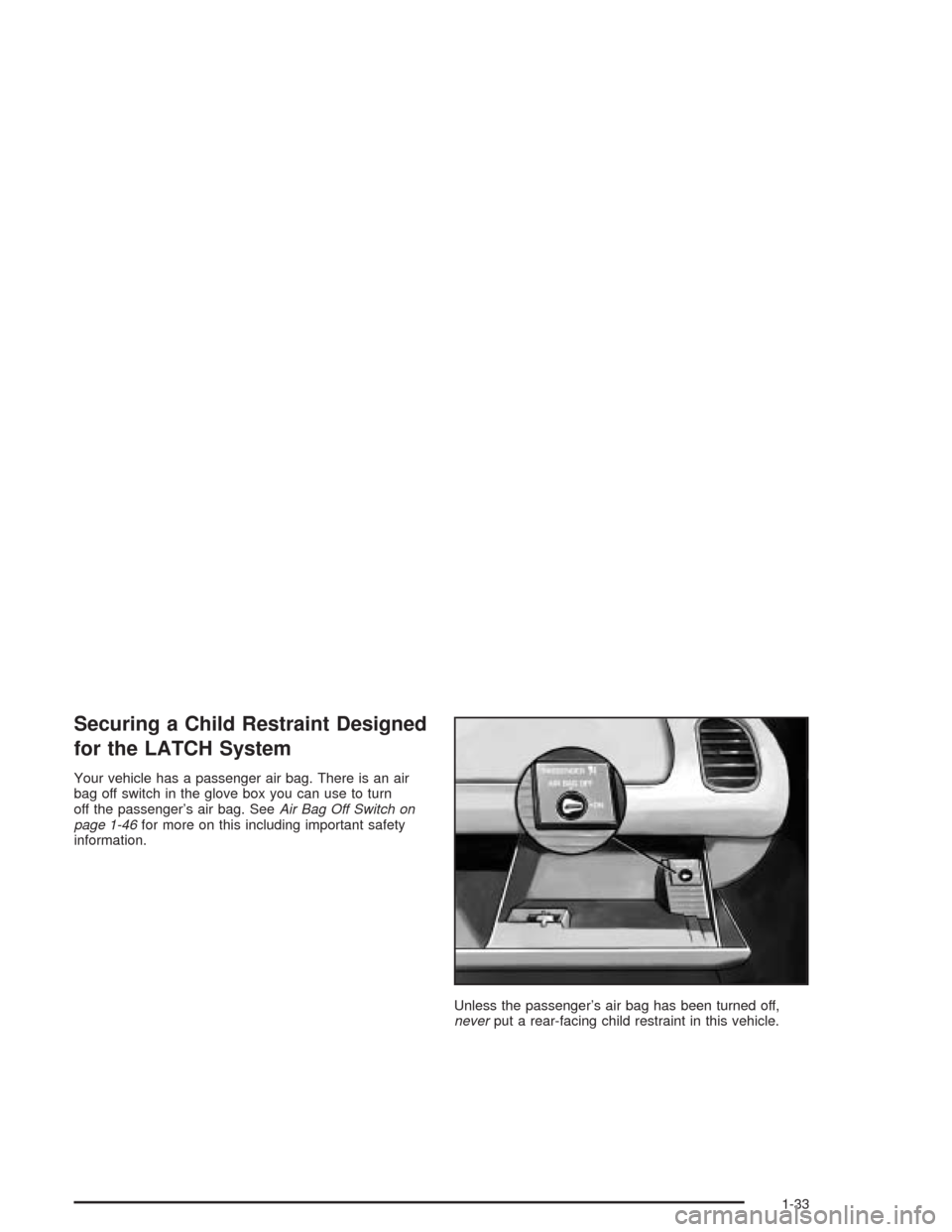
Securing a Child Restraint Designed
for the LATCH System
Your vehicle has a passenger air bag. There is an air
bag off switch in the glove box you can use to turn
off the passenger’s air bag. SeeAir Bag Off Switch on
page 1-46for more on this including important safety
information.
Unless the passenger’s air bag has been turned off,
neverput a rear-facing child restraint in this vehicle.
1-33
Page 42 of 384
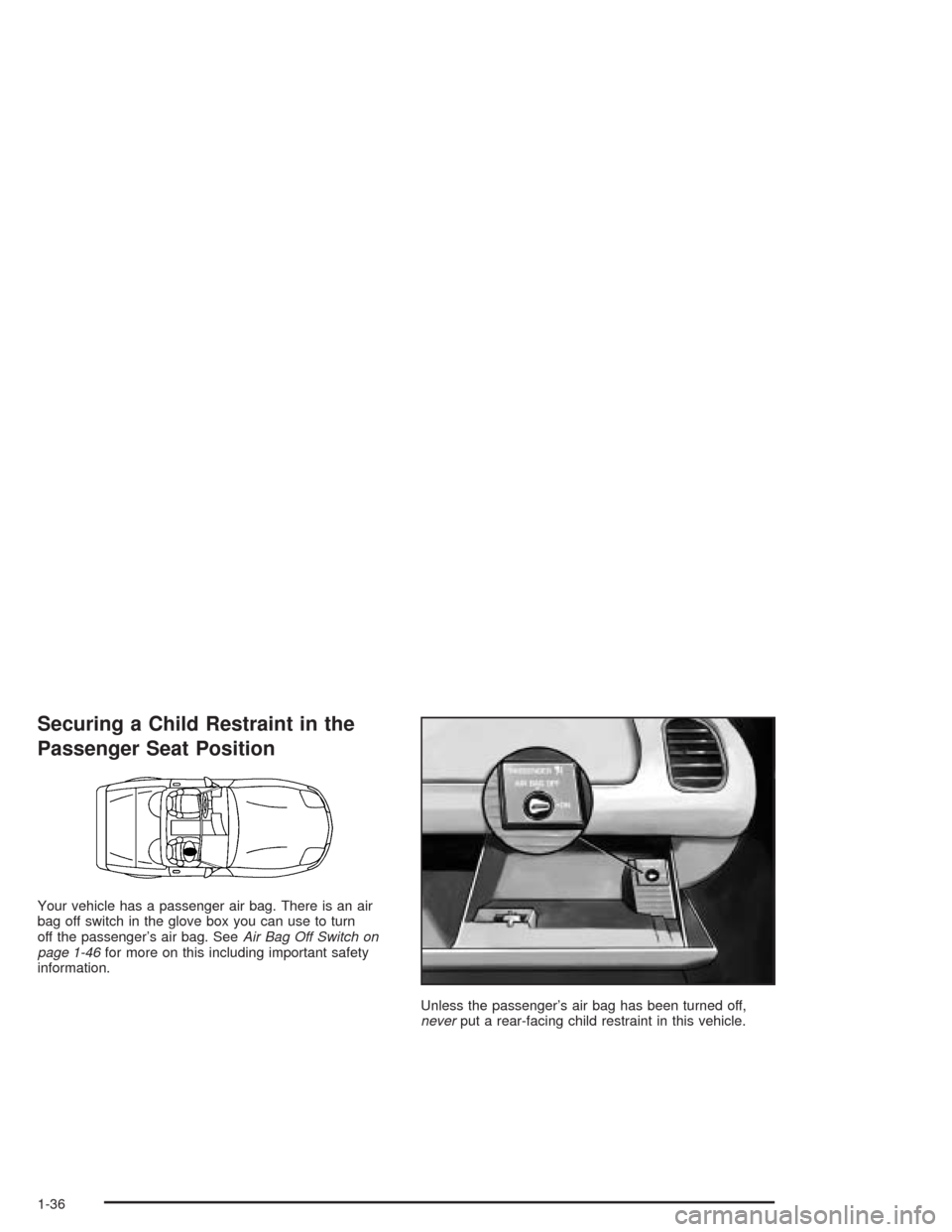
Securing a Child Restraint in the
Passenger Seat Position
Your vehicle has a passenger air bag. There is an air
bag off switch in the glove box you can use to turn
off the passenger’s air bag. SeeAir Bag Off Switch on
page 1-46for more on this including important safety
information.
Unless the passenger’s air bag has been turned off,
neverput a rear-facing child restraint in this vehicle.
1-36
Page 52 of 384
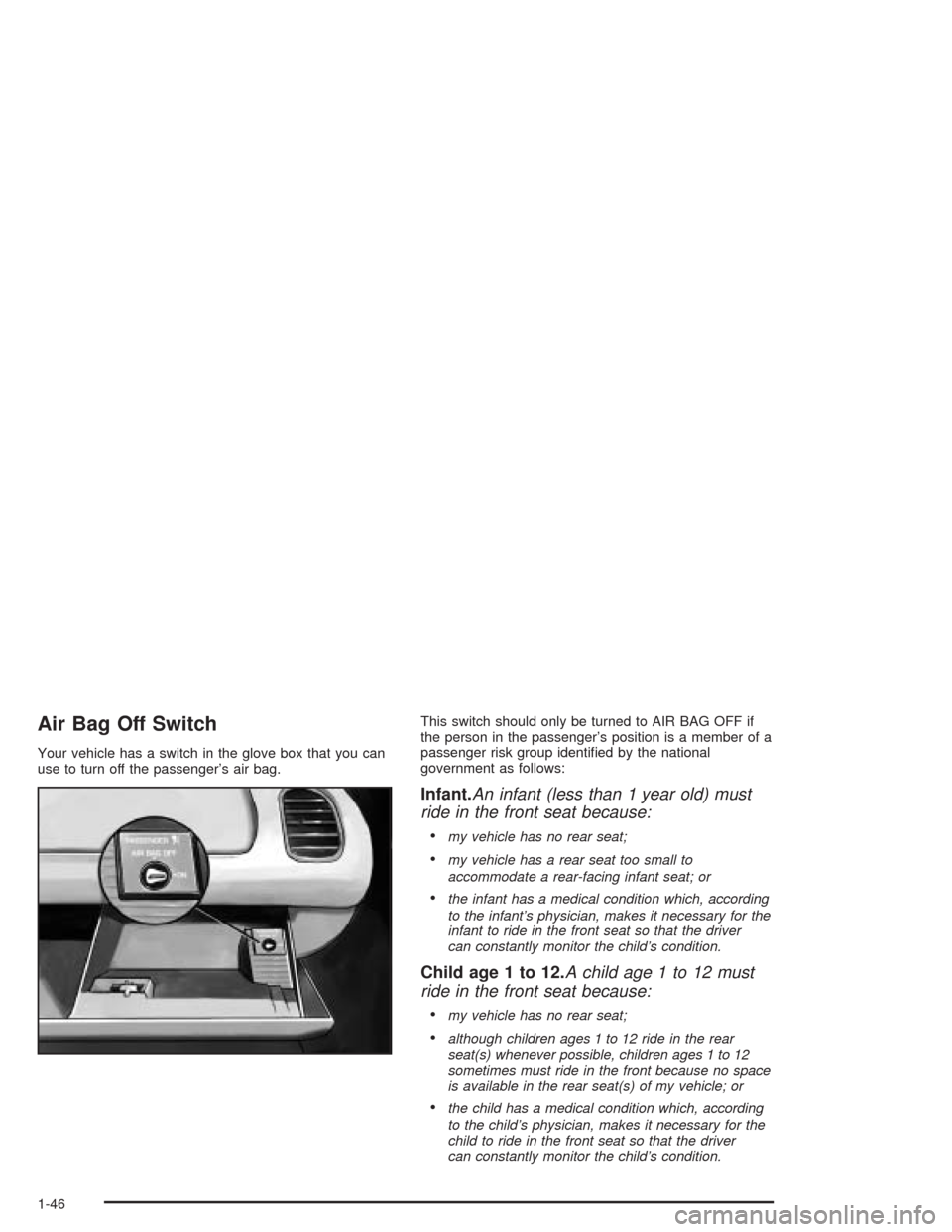
Air Bag Off Switch
Your vehicle has a switch in the glove box that you can
use to turn off the passenger’s air bag.This switch should only be turned to AIR BAG OFF if
the person in the passenger’s position is a member of a
passenger risk group identified by the national
government as follows:
Infant.An infant (less than 1 year old) must
ride in the front seat because:
•
my vehicle has no rear seat;
•my vehicle has a rear seat too small to
accommodate a rear-facing infant seat; or
•the infant has a medical condition which, according
to the infant’s physician, makes it necessary for the
infant to ride in the front seat so that the driver
can constantly monitor the child’s condition.
Child age 1 to 12.A child age 1 to 12 must
ride in the front seat because:
•
my vehicle has no rear seat;
•although children ages 1 to 12 ride in the rear
seat(s) whenever possible, children ages 1 to 12
sometimes must ride in the front because no space
is available in the rear seat(s) of my vehicle; or
•the child has a medical condition which, according
to the child’s physician, makes it necessary for the
child to ride in the front seat so that the driver
can constantly monitor the child’s condition.
1-46
Page 57 of 384
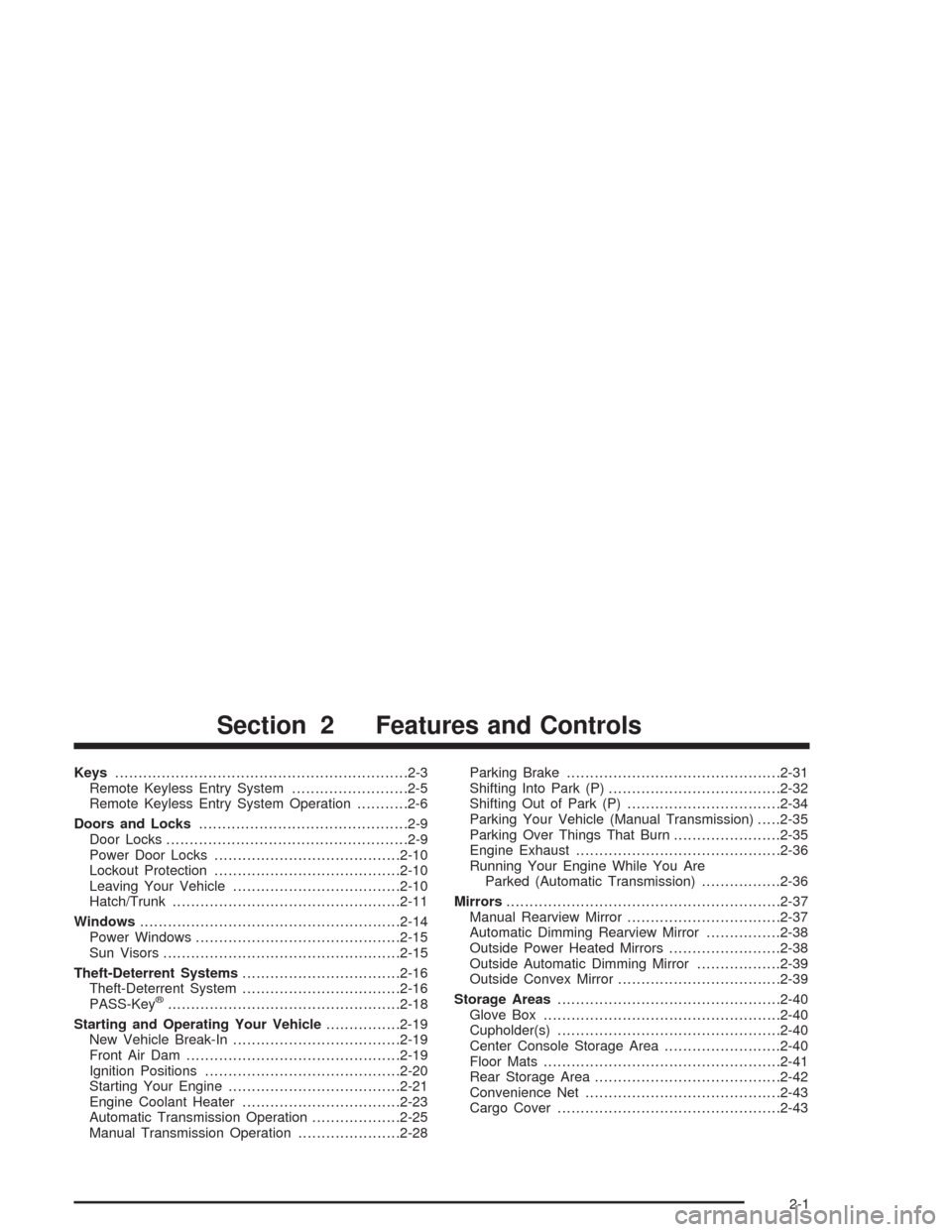
Keys...............................................................2-3
Remote Keyless Entry System.........................2-5
Remote Keyless Entry System Operation...........2-6
Doors and Locks.............................................2-9
Door Locks....................................................2-9
Power Door Locks........................................2-10
Lockout Protection........................................2-10
Leaving Your Vehicle....................................2-10
Hatch/Trunk.................................................2-11
Windows........................................................2-14
Power Windows............................................2-15
Sun Visors...................................................2-15
Theft-Deterrent Systems..................................2-16
Theft-Deterrent System..................................2-16
PASS-Key
®..................................................2-18
Starting and Operating Your Vehicle................2-19
New Vehicle Break-In....................................2-19
Front Air Dam..............................................2-19
Ignition Positions..........................................2-20
Starting Your Engine.....................................2-21
Engine Coolant Heater..................................2-23
Automatic Transmission Operation...................2-25
Manual Transmission Operation......................2-28Parking Brake..............................................2-31
Shifting Into Park (P).....................................2-32
Shifting Out of Park (P).................................2-34
Parking Your Vehicle (Manual Transmission).....2-35
Parking Over Things That Burn.......................2-35
Engine Exhaust............................................2-36
Running Your Engine While You Are
Parked (Automatic Transmission).................2-36
Mirrors...........................................................2-37
Manual Rearview Mirror.................................2-37
Automatic Dimming Rearview Mirror................2-38
Outside Power Heated Mirrors........................2-38
Outside Automatic Dimming Mirror..................2-39
Outside Convex Mirror...................................2-39
Storage Areas................................................2-40
Glove Box...................................................2-40
Cupholder(s)................................................2-40
Center Console Storage Area.........................2-40
Floor Mats...................................................2-41
Rear Storage Area........................................2-42
Convenience Net..........................................2-43
Cargo Cover................................................2-43
Section 2 Features and Controls
2-1
Page 96 of 384
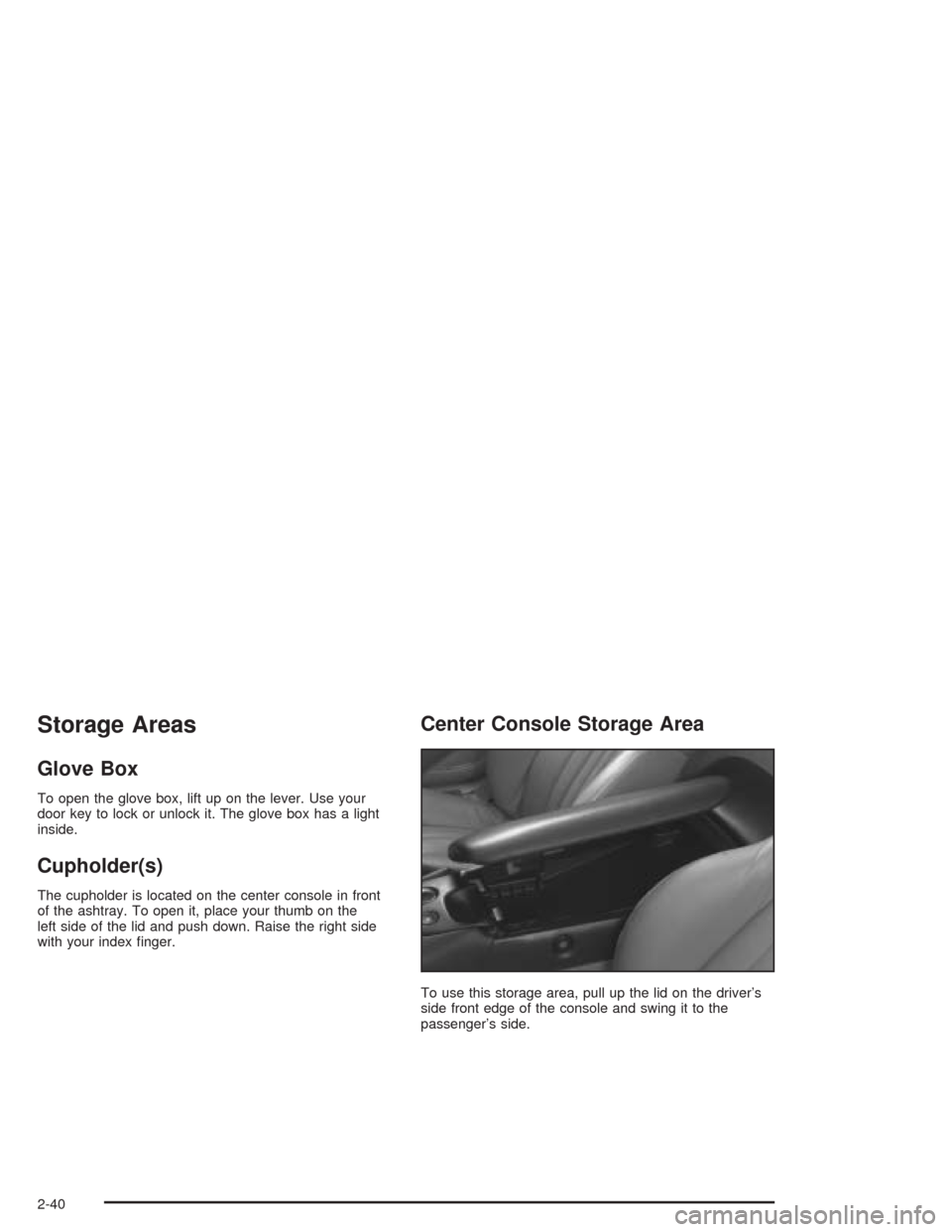
Storage Areas
Glove Box
To open the glove box, lift up on the lever. Use your
door key to lock or unlock it. The glove box has a light
inside.
Cupholder(s)
The cupholder is located on the center console in front
of the ashtray. To open it, place your thumb on the
left side of the lid and push down. Raise the right side
with your index finger.
Center Console Storage Area
To use this storage area, pull up the lid on the driver’s
side front edge of the console and swing it to the
passenger’s side.
2-40
Page 117 of 384
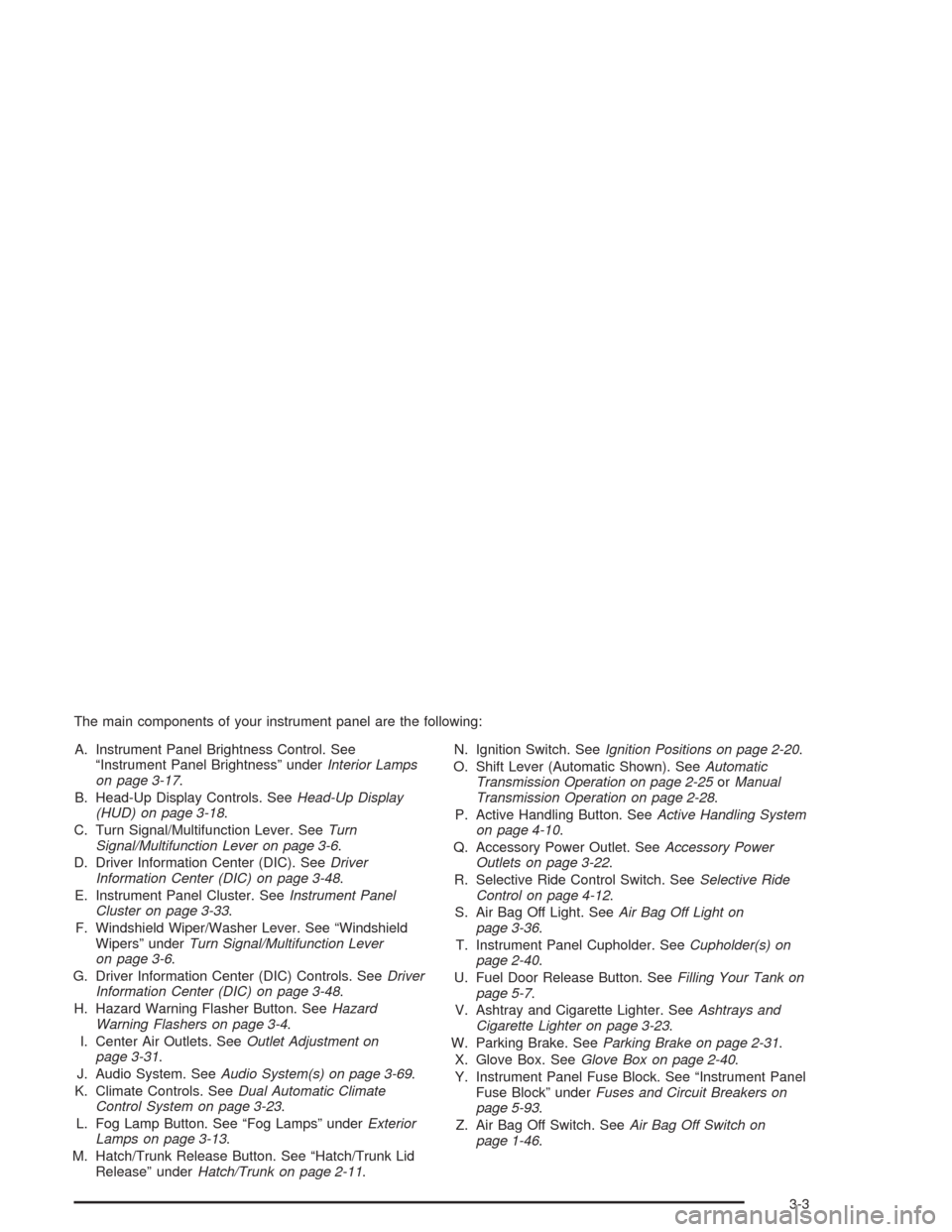
The main components of your instrument panel are the following:
A. Instrument Panel Brightness Control. See
“Instrument Panel Brightness” underInterior Lamps
on page 3-17.
B. Head-Up Display Controls. SeeHead-Up Display
(HUD) on page 3-18.
C. Turn Signal/Multifunction Lever. SeeTurn
Signal/Multifunction Lever on page 3-6.
D. Driver Information Center (DIC). SeeDriver
Information Center (DIC) on page 3-48.
E. Instrument Panel Cluster. SeeInstrument Panel
Cluster on page 3-33.
F. Windshield Wiper/Washer Lever. See “Windshield
Wipers” underTurn Signal/Multifunction Lever
on page 3-6.
G. Driver Information Center (DIC) Controls. SeeDriver
Information Center (DIC) on page 3-48.
H. Hazard Warning Flasher Button. SeeHazard
Warning Flashers on page 3-4.
I. Center Air Outlets. SeeOutlet Adjustment on
page 3-31.
J. Audio System. SeeAudio System(s) on page 3-69.
K. Climate Controls. SeeDual Automatic Climate
Control System on page 3-23.
L. Fog Lamp Button. See “Fog Lamps” underExterior
Lamps on page 3-13.
M. Hatch/Trunk Release Button. See “Hatch/Trunk Lid
Release” underHatch/Trunk on page 2-11.N. Ignition Switch. SeeIgnition Positions on page 2-20.
O. Shift Lever (Automatic Shown). SeeAutomatic
Transmission Operation on page 2-25orManual
Transmission Operation on page 2-28.
P. Active Handling Button. SeeActive Handling System
on page 4-10.
Q. Accessory Power Outlet. SeeAccessory Power
Outlets on page 3-22.
R. Selective Ride Control Switch. SeeSelective Ride
Control on page 4-12.
S. Air Bag Off Light. SeeAir Bag Off Light on
page 3-36.
T. Instrument Panel Cupholder. SeeCupholder(s) on
page 2-40.
U. Fuel Door Release Button. SeeFilling Your Tank on
page 5-7.
V. Ashtray and Cigarette Lighter. SeeAshtrays and
Cigarette Lighter on page 3-23.
W. Parking Brake. SeeParking Brake on page 2-31.
X. Glove Box. SeeGlove Box on page 2-40.
Y. Instrument Panel Fuse Block. See “Instrument Panel
Fuse Block” underFuses and Circuit Breakers on
page 5-93.
Z. Air Bag Off Switch. SeeAir Bag Off Switch on
page 1-46.
3-3
Page 132 of 384
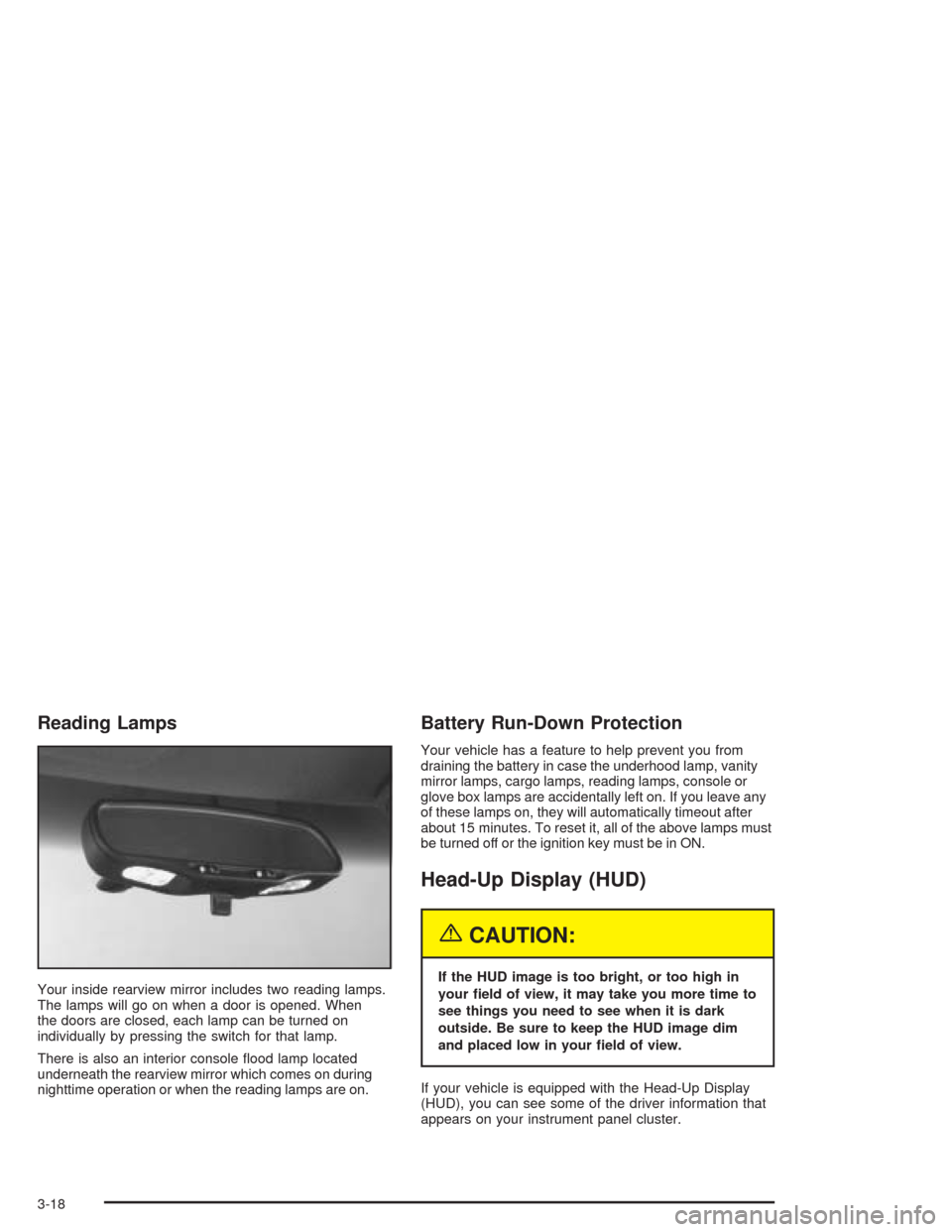
Reading Lamps
Your inside rearview mirror includes two reading lamps.
The lamps will go on when a door is opened. When
the doors are closed, each lamp can be turned on
individually by pressing the switch for that lamp.
There is also an interior console flood lamp located
underneath the rearview mirror which comes on during
nighttime operation or when the reading lamps are on.
Battery Run-Down Protection
Your vehicle has a feature to help prevent you from
draining the battery in case the underhood lamp, vanity
mirror lamps, cargo lamps, reading lamps, console or
glove box lamps are accidentally left on. If you leave any
of these lamps on, they will automatically timeout after
about 15 minutes. To reset it, all of the above lamps must
be turned off or the ignition key must be in ON.
Head-Up Display (HUD)
{CAUTION:
If the HUD image is too bright, or too high in
your �eld of view, it may take you more time to
see things you need to see when it is dark
outside. Be sure to keep the HUD image dim
and placed low in your �eld of view.
If your vehicle is equipped with the Head-Up Display
(HUD), you can see some of the driver information that
appears on your instrument panel cluster.
3-18
Page 334 of 384
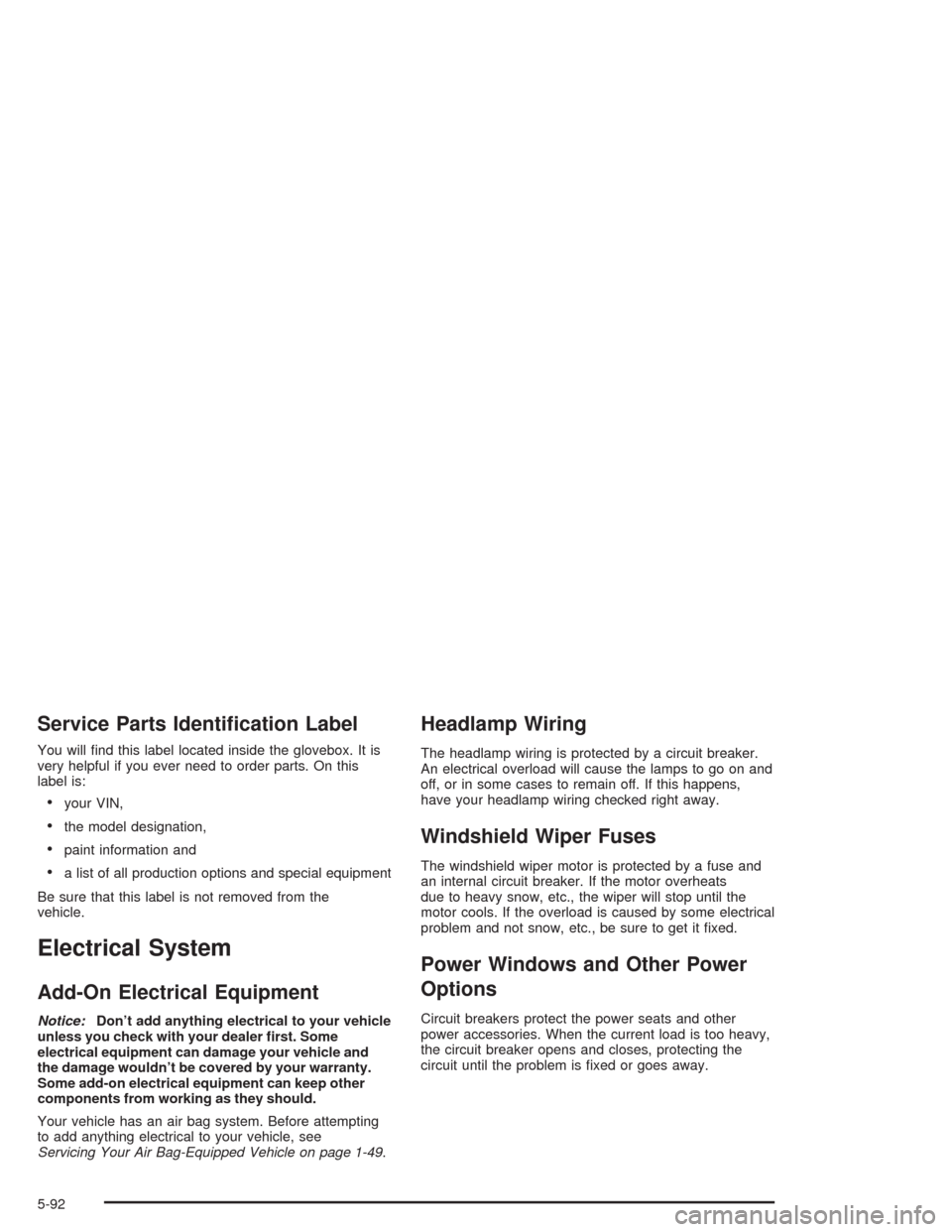
Service Parts Identi�cation Label
You will find this label located inside the glovebox. It is
very helpful if you ever need to order parts. On this
label is:
•your VIN,
•the model designation,
•paint information and
•a list of all production options and special equipment
Be sure that this label is not removed from the
vehicle.
Electrical System
Add-On Electrical Equipment
Notice:Don’t add anything electrical to your vehicle
unless you check with your dealer �rst. Some
electrical equipment can damage your vehicle and
the damage wouldn’t be covered by your warranty.
Some add-on electrical equipment can keep other
components from working as they should.
Your vehicle has an air bag system. Before attempting
to add anything electrical to your vehicle, see
Servicing Your Air Bag-Equipped Vehicle on page 1-49.
Headlamp Wiring
The headlamp wiring is protected by a circuit breaker.
An electrical overload will cause the lamps to go on and
off, or in some cases to remain off. If this happens,
have your headlamp wiring checked right away.
Windshield Wiper Fuses
The windshield wiper motor is protected by a fuse and
an internal circuit breaker. If the motor overheats
due to heavy snow, etc., the wiper will stop until the
motor cools. If the overload is caused by some electrical
problem and not snow, etc., be sure to get it fixed.
Power Windows and Other Power
Options
Circuit breakers protect the power seats and other
power accessories. When the current load is too heavy,
the circuit breaker opens and closes, protecting the
circuit until the problem is fixed or goes away.
5-92
Page 376 of 384
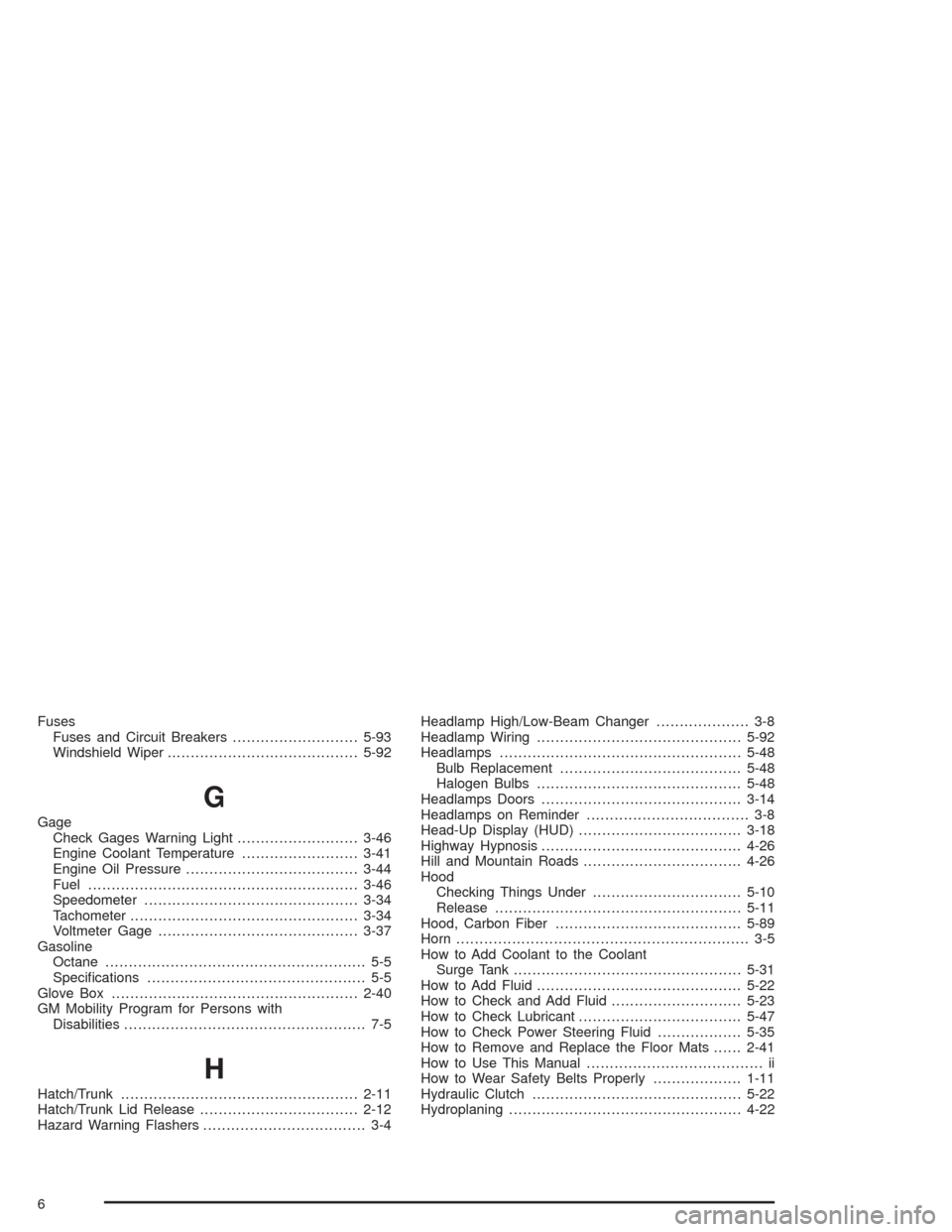
Fuses
Fuses and Circuit Breakers...........................5-93
Windshield Wiper.........................................5-92
G
Gage
Check Gages Warning Light..........................3-46
Engine Coolant Temperature.........................3-41
Engine Oil Pressure.....................................3-44
Fuel..........................................................3-46
Speedometer..............................................3-34
Tachometer.................................................3-34
Voltmeter Gage...........................................3-37
Gasoline
Octane........................................................ 5-5
Specifications............................................... 5-5
Glove Box.....................................................2-40
GM Mobility Program for Persons with
Disabilities.................................................... 7-5
H
Hatch/Trunk...................................................2-11
Hatch/Trunk Lid Release..................................2-12
Hazard Warning Flashers................................... 3-4Headlamp High/Low-Beam Changer.................... 3-8
Headlamp Wiring............................................5-92
Headlamps....................................................5-48
Bulb Replacement.......................................5-48
Halogen Bulbs............................................5-48
Headlamps Doors...........................................3-14
Headlamps on Reminder................................... 3-8
Head-Up Display (HUD)...................................3-18
Highway Hypnosis...........................................4-26
Hill and Mountain Roads..................................4-26
Hood
Checking Things Under................................5-10
Release.....................................................5-11
Hood, Carbon Fiber........................................5-89
Horn............................................................... 3-5
How to Add Coolant to the Coolant
Surge Tank.................................................5-31
How to Add Fluid............................................5-22
How to Check and Add Fluid............................5-23
How to Check Lubricant...................................5-47
How to Check Power Steering Fluid..................5-35
How to Remove and Replace the Floor Mats......2-41
How to Use This Manual...................................... ii
How to Wear Safety Belts Properly...................1-11
Hydraulic Clutch.............................................5-22
Hydroplaning..................................................4-22
6
Page 382 of 384
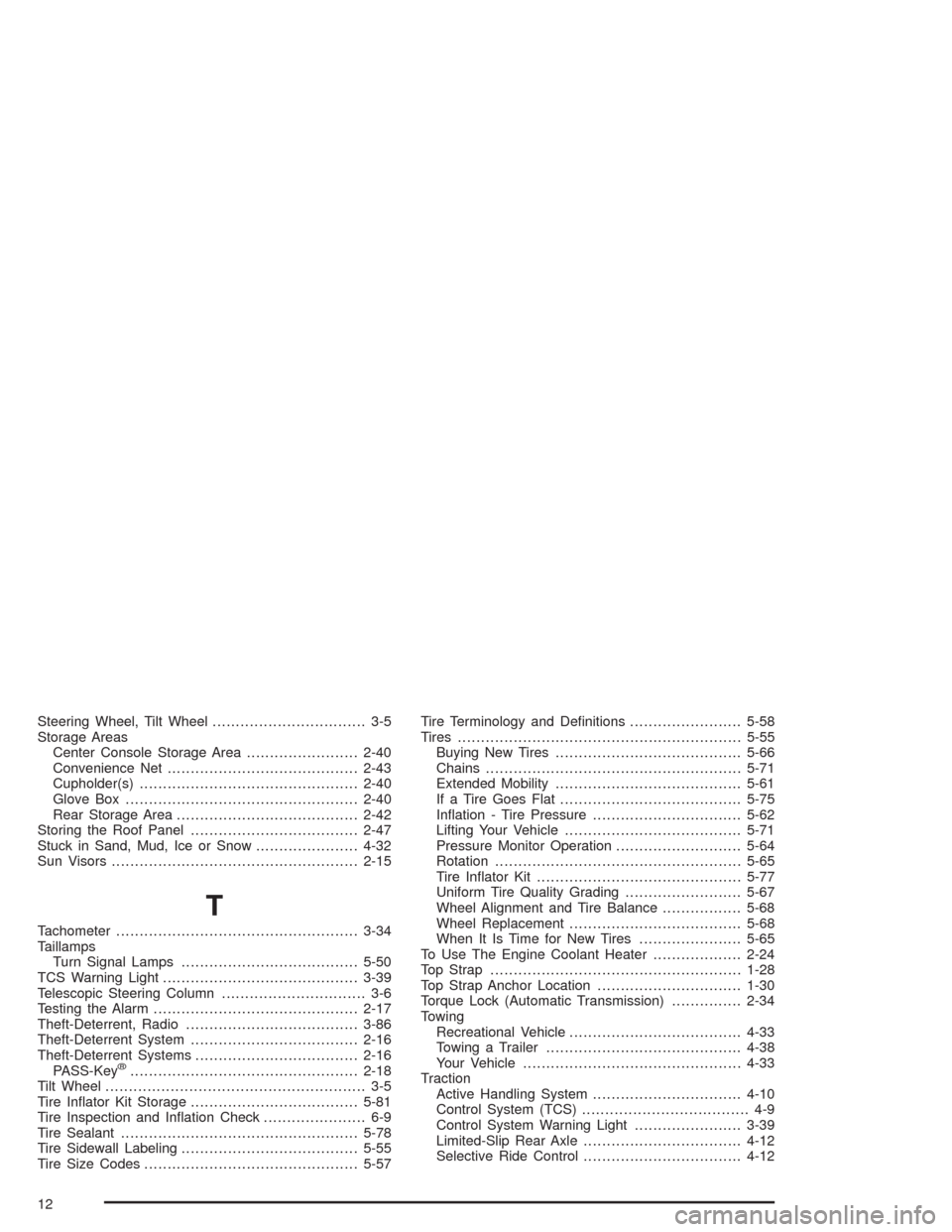
Steering Wheel, Tilt Wheel................................. 3-5
Storage Areas
Center Console Storage Area........................2-40
Convenience Net.........................................2-43
Cupholder(s)...............................................2-40
Glove Box..................................................2-40
Rear Storage Area.......................................2-42
Storing the Roof Panel....................................2-47
Stuck in Sand, Mud, Ice or Snow......................4-32
Sun Visors.....................................................2-15
T
Tachometer....................................................3-34
Taillamps
Turn Signal Lamps......................................5-50
TCS Warning Light..........................................3-39
Telescopic Steering Column............................... 3-6
Testing the Alarm............................................2-17
Theft-Deterrent, Radio.....................................3-86
Theft-Deterrent System....................................2-16
Theft-Deterrent Systems...................................2-16
PASS-Key
®.................................................2-18
Tilt Wheel........................................................ 3-5
Tire Inflator Kit Storage....................................5-81
Tire Inspection and Inflation Check...................... 6-9
Tire Sealant...................................................5-78
Tire Sidewall Labeling......................................5-55
Tire Size Codes..............................................5-57Tire Terminology and Definitions........................5-58
Tires.............................................................5-55
Buying New Tires........................................5-66
Chains.......................................................5-71
Extended Mobility........................................5-61
If a Tire Goes Flat.......................................5-75
Inflation - Tire Pressure................................5-62
Lifting Your Vehicle......................................5-71
Pressure Monitor Operation...........................5-64
Rotation.....................................................5-65
Tire Inflator Kit............................................5-77
Uniform Tire Quality Grading.........................5-67
Wheel Alignment and Tire Balance.................5-68
Wheel Replacement.....................................5-68
When It Is Time for New Tires......................5-65
To Use The Engine Coolant Heater...................2-24
Top Strap......................................................1-28
Top Strap Anchor Location...............................1-30
Torque Lock (Automatic Transmission)...............2-34
Towing
Recreational Vehicle.....................................4-33
Towing a Trailer..........................................4-38
Your Vehicle...............................................4-33
Traction
Active Handling System................................4-10
Control System (TCS).................................... 4-9
Control System Warning Light.......................3-39
Limited-Slip Rear Axle..................................4-12
Selective Ride Control..................................4-12
12